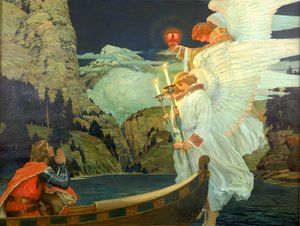Holy Grail

According to Arthurian legend, the cup from which Jesus drank at the Last Supper, brought by Joseph of Arimathea to Glastonbury, which was then an island in southwest England. The focal point was thus set for the dispensation of Camelot, a mystery school founded on the concept of the quest for the Holy Grail as a path of discipline and initiation.
Arthurian legend
It is not clear from the mass of conflicting legends what exactly the Grail was or is. It was variously described as a chalice or cup, a stone, a serving dish, or even Christ himself. Most probable is that the mystical Grail presence takes on different forms in the minds of those who see it, or desire to, according to their capacity for understanding.
According to legend, each year at the feast of Pentecost the knights of the Round Table returned to Camelot and rendered to the king and queen the reports of their deeds during the year. One Pentecost as the knights were gathered at the Round Table they saw a vision of the Holy Grail “so filled with glorious light that none might behold it.” Sir Gawain and many of the others made the vow never to return again to the court until they had seen the Holy Grail more openly.
Alfred Lord Tennyson in Idylls of the King records that upon hearing their vow King Arthur cried, “Woe is me, my knights!... Go, since your vows are sacred, being made. Yet—for ye know the cries of all my realm pass thro’ this hall—how often, O my knights, your places being vacant at my side, this chance of noble deeds will come and go unchallenged, while ye follow wandering fires lost in the quagmire! Many of you, yea most, return no more.”
Of the 150 knights of the Round Table who went forth to quest the Grail, only four saw it—Galahad, Percival, Bors, and Lancelot.
All others were searching for that which they did not understand, which they did not know, for which they did not have the spiritual capacity to perceive. Their grail was the Matter cup; their grail was the responsibility for service to life here and now in the practical domain.
A universal archetype
Other cultures also have heroes who quest grail-like objects. China, India, Tibet, Egypt, Wales, and Ireland are among the nations which preserve legends paralleling the search for the Holy Cup. The coincidences between sets of legends are striking. These outcroppings of the Grail theme are hard to explain merely as versions of the same story transferred by migration. Rather, they seem to take root, flourish and enthrall civilizations around the world because they are an essential element in man’s nature.
Emma Jung, psychologist and wife of Carl Jung, explains in her book The Grail Legend that this phenomenon results from the universal archetypal basis of the theme. She explains that “the fascination and vitality of myths and fairy-tales lie precisely in the fact that they depict basic forms of human experience. For this very reason the same motifs are found the world over, not only as the result of migration but also because the human psyche which produces them is everywhere the same.”
The significance of the Grail today
El Morya speaks of the mystical significance of the Holy Grail today:
- Oh, there is a Holy Grail indeed! and long ago it was placed at Glastonbury. But, precious ones, today it has been spiritually amplified until replicas of that Holy Grail are placed as a filigree radiance of light around each human heart who aspires to become a chalice of Christed opportunity. And so tonight I tell you that the Holy Grail is within your own heart, and you are knights to guard that Grail against impure thoughts, impure motives, impure desires, impure ideas of every type and kind.[1]
The concept of the physical cup, the tangible Grail that the mind and hand can grasp, is the magnet that rallies souls to take up the spiritual quest—lifetime after lifetime—of discovering and becoming the inner light and the Holy Grail.
See also
Sources
Elizabeth Clare Prophet, Inner Perspectives, chapter 23.
Heart magazine, winter 1985 issue.
Elizabeth Clare Prophet, July 4, 1978.
- ↑ Mark L. Prophet and Elizabeth Clare Prophet, MORYA: The Darjeeling Master Speaks to His Chelas on the Quest for the Holy Grail (1983), p. 185.
